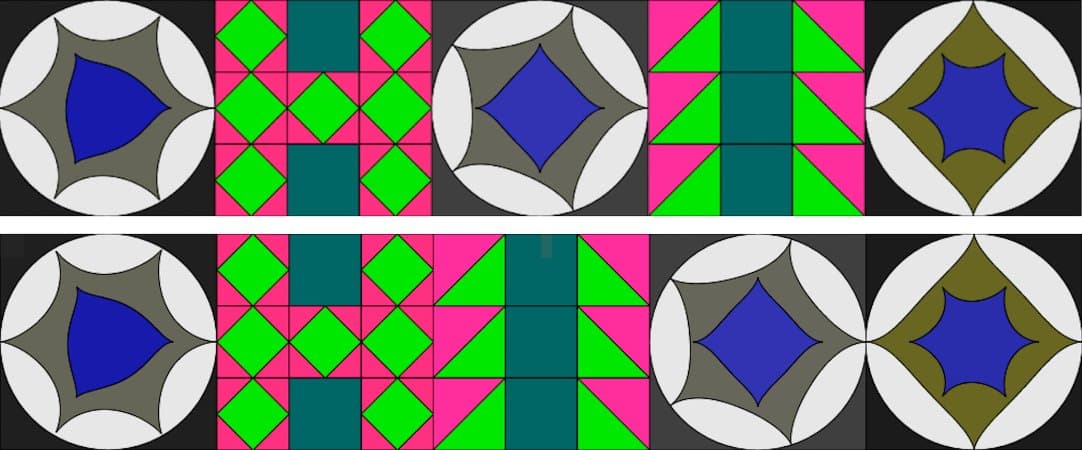Summary: Seven-month-old babies are able to detect whether a mosaic has a symmetrical structure, suggesting an automatic ability to extract structural patterns from complex images.
Source: University of the Basque Country
A collaborative study conducted by the UPV/EHU’s Gogo Elebiduna group examined the spontaneous looking patterns of seven-month-old babies when presented with mosaic-like sequences with a symmetrical and asymmetrical structure.
The results show that these babies quickly detect whether a mosaic has a symmetrical structure, suggesting a robust, automatic ability to extract structure from complex images.
The UPV/EHU’s Gogo Elebiduna research group is a pioneer in the field of psycholinguistics; it conducts research of various kinds to obtain knowledge about how the language faculty is acquired, represented and organized in the brains of speakers, and about the nature of the universal characteristics of language representation and processing.
The group’s Ikerbasque research fellow Irene de la Cruz-Pavía conducted a study in collaboration with the University of Padua researcher Judit Gervain and which was recently published in the journal PLOS ONE; it explores the ability of 7-month-old infants to perceive structural symmetry in abstract, mosaic-like visual patterns.
This research was carried out at the University of Paris. “We examined the spontaneous looking patterns of almost 100 infants when presented with mosaic-like sequences displaying symmetrical and asymmetrical structures,” the researchers explained.
These mosaics comprised two categories of square tiles (A and B) that differed in terms of their color scheme and internal shape. These tiles were arranged to create mosaics with symmetrical (e.g. ABA, ABABA) or asymmetrical (e.g. AAB, AABBA) structures.
The study found that the infants “discriminated between structurally symmetrical and asymmetrical mosaics, and that the length of the sequence (three or five tiles) or the level of symmetry did not significantly modulate their behavior.”
These results suggest that infants quickly detect structural symmetry in complex visual patterns: “Babies as young as seven months have a robust, automatic ability to detect that a structure is symmetrical.
” This ability coincides with those found in studies we conducted using other stimuli, such as sign language or speech, demonstrating that babies are simply very good at detecting structures and regularities,” said de la Cruz-Pavía.
Ability of babies to extract structure and rules from various media
“The grammar of a language consists of the set of structures and rules of a language. I want to understand to what extent infants’ abilities to extract structures, detect regularities and learn rules are specific to language or whether they are found in other areas,” said de la Cruz-Pavía.

“We conducted this study using information that is visual but which is not language. With these mosaics, we were able to see how babies were capable of extracting structure from different media.”
The researchers stress that this study allows them to better understand “these infants’ fundamental skills, which will enable them to start initially with some of the more accessible parts of grammar and gradually build up to something as complex as the grammar of a language. What we want to understand is this: what are the fundamental abilities of babies when it comes to detecting structure?”
“We have many more questions to answer,” they concluded. “In this study we were able to determine that babies are able to detect structures spontaneously and quickly. Now we want to understand when this ability begins, and the degree of detail with which they analyze that structure and what aspects of the mosaics allow them to detect its structure (the shape, the color, both…).”
About this neurodevelopment and visual neuroscience research news
Author: Press Office
Source: University of the Basque Country
Contact: Press Office – University of the Basque Country
Image: The image is credited to Irene de la Cruz-Pavía / UPV/EHU
Original Research: Open access.
“Seven-month-old infants detect symmetrical structures in multi-featured abstract visual patterns” by Irene de la Cruz-Pavía et al. PLOS ONE
Abstract
Seven-month-old infants detect symmetrical structures in multi-featured abstract visual patterns
The present study investigated 7-month-old infants’ ability to perceive structural symmetry in mosaic-like abstract visual patterns. We examined infants’ (n = 98) spontaneous looking behaviour to mosaic-like sequences with symmetrical and asymmetrical structures.
Sequences were composed of square tiles from two categories that differed in their colour scheme and internal shape. We manipulated sequence length (3 or 5 tiles) and abstractness of the symmetry (token vs. category level).
The 7-month-olds discriminated structurally symmetrical from asymmetrical mosaics in the first half of the test phase (first 8 trials). Sequence length, level of symmetry, or number of unique tiles per sequence did not significantly modulate infants’ looking behaviour.
These results suggest that very young infants detect differences in structural symmetry in multi-featured visual patterns.







